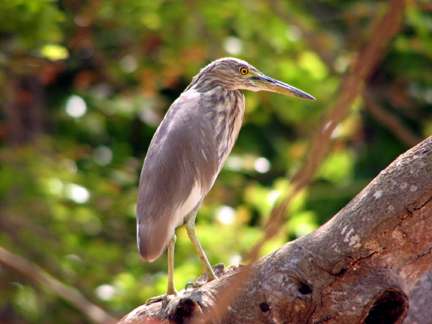Pond Heron or Paddy bird.( Ardeola grayii)
-Ragoo Rao
I have chosen the Pond heron for introduction this month. The reason for this selection is, when summer comes and the
ponds and paddy fields are dry and parched, these birds come into the urban areas into parks and open sites looking for insects and centipedes hiding under rocks and small shrubs. This is the reason these birds can be noticed more around summer in urban areas
than in any other season.

When one walks around marsh areas or paddy fields, an earthy brown colored bird with long legs about the size of an egret
can hardly be noticed because of their camouflaged upper body coloring, but when they get startled and take off, their glistening white wings and lower body gets noticed. In flight this heron appears to be a white bird and when it again lands it just merges
into its surroundings and once again it can hardly be sighted. This is the Pond heron or more commonly known as the Paddy bird because it is very commonly found on the bunds of paddy fields foraging for small crustaceans and insects.
These birds are common throughout the country except for very highly elevated places. The pond heron’s typical habit of
foraging is to stand rock still gazing into the water and suddenly dart the long neck and get the prey. Even its walk is a deliberate " one leg at a time pulled and stretched to take the next step" all this in a kind of slow motion. These birds have very keen
eye-sight and hearing. It is always the bird which notices you first and either stands still or just takes off. This is a very stealthy bird and it is very difficult to get close to it.
These birds are often found in small to large flocks and they always roost in their favorite trees very close to the water
bodies and sometimes even in tall trees in urban gardens.
In the breeding season which is mainly around May to September these birds take on maroon hair like plumes on their back and long white patch around their eyes. The nesting season varies in South-India which is chiefly around November to Januaray.
Nesting is done on large Mango, Tamarind and Neem trees and the nest looks similar to that of crows- an untidy mass of twigs lined with feathers.
Large flocks share a common tree for nesting. 3 to 5 pale green eggs are laid and both parents appear to share all domestic chores. Both sexes are alike and it is very difficult to differentiate unless on very close and constant observation of a particular
breeding pair.
These marvelous birds might also become rare because of the lavish and indiscriminate dumping of pesticides on paddy crops
which is their main foraging grounds. Let us hope we will strike a good balance in our pesticide usage and allow these marvelous fellow creatures of this planet to survive along with us.
Once a species goes, there is no way of bringing it back. Let us not lose any of them.